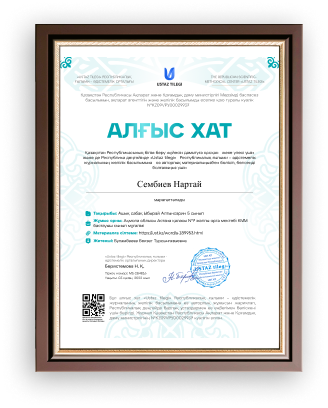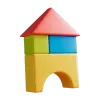
Weekly Plan for 2024-2025
|
Term No: 3 |
Week No: 2 |
Subject: Further English 5 |
Grade: 5 |
Teacher: Arailym Tulegenova |
|
Textbook: I Wonder 6 |
||||
|
Day/Date Duration 40m/80m |
Unit/Topic |
Framework Code(s) |
Learning Objective(s) |
Activities |
Resources and Materials |
|
Day 1 40 mins |
Unit 5: Food Around the World Cooking Instructions A lot of, much, many, a few, a little Sequencing instructions |
|
To learn and talk about cooking instructions, cooking preferences, food and food quantities.
Language Revision: second conditional
Target Vocabulary: bake, boil, chop, fry, grate, mash, peel, slice
Structures: a lot of/much/many/a few/a little Language in use: How do you like your fish? Baked. How about you? I like fried fish! We need a lot of cheese. We don't need many olives.
Think Thinking Skills I Applying world knowledge (Ex. 2).
|
BEGINNING THE LESSON AIM: To revise the language of the previous lesson. Write some prompts on the board (e.g. see a mouse, lose your wallet, sleep early, etc.). Ask individual pupils to make sentences using the prompts and the second conditional. Ask the rest of the class for verification.
Language in Action PRESENTATION & PRACTICE
1 Listen. Repeat. (Track 17 CD2) AIM: To present vocabulary related to cooking instructions. POSTER Books closed. Put the Cooking Instructions poster up on the board. Point to the pictures and name them. The pupils repeat after you. Point to the pictures in random order and ask individual pupils to name them. Ask the rest of the class for verification. Then, ask the pupils to name food items they can fry, slice, boil, etc. Elicit answers from around the class. Books open. Play the audio. The pupils listen and repeat, chorally and/or individually.
How do you like your food? Boiled, fried or baked? Talk with your friend. AIM: To talk about cooking preferences. Read out the example and explain the activity. In pairs, the pupils ask and answer questions about how they like their food cooked. Go around the classroom providing any necessary help. Ask some pairs to report back to the class.
Suggested answer key A: How do you like your potatoes? B: Boiled. How about you? A: I like baked potatoes! etc.
2 Think Read and choose. AIM: To practice vocabulary related to cooking instructions. Go through the prompts and elicit/explain any unknown words. The pupils read and choose the correct answers. Ask individual pupils to answer. Ask the rest of the class for verification.
3 Game Let's play the Can you help me with dinner? game! AIM: To further practice vocabulary related to cooking instructions through a game. Divide the class into two teams, A and B. Write on the board: Can you help me with dinner? Of course. Shall I slice the mushrooms for you? Invite a pupil from each team to come to the board. Write a food item on the board (e.g. potatoes). The first pupil asks the question and the second offers to help by doing something with the food item (e.g. Shall I peel the potatoes for you?). Then, the teams swap roles. Each correct answer gets a point. The pupils can win extra points if they mention more than one cooking instruction (e.g. Shall I peel and boil the potatoes for you?). The team with the most points wins.
WONDER Grammar PRESENTATION & PRACTICE 4 A lot of, a few or a little? Look, read and complete. AIM: To present/revise and practice a lot of, much many, a few, a little.
Books closed. Say, as you write on the board: There are a lot of oranges. Are there many oranges? No there aren't many oranges. Underline the words in bold. Elicit the use of a lot of in the affirmative, and many in the negative and interrogative with countable nouns. Repeat the procedure and present a lot of and much for uncountable nouns. Then say, as you write on the board: There are a few oranges. We can make some juice. There is a little flour. We can make a cake. Elicit/Explain that we use a few with countable nouns to mean not many, but enough and that we use a little with uncountable nouns to mean not much, but enough. Revise the use of any in the interrogative and negative form.
Books open. Go through the Grammar box briefly and explain the activity. The pupils look at the pictures and complete the sentences with a lot of, a few or a little. Check their answers.
5 Read, choose and complete. AIM: To further practice a lot of, much, many, a few, a little. Read out the first exchange and explain the activity. The pupils read the dialogue and choose the correct items. Check their answers.
ENDING THE LESSON AIM: To consolidate the language of the lesson. Write the following headings on the board: fry, slice, boil, chop, peel, mash, grate, bake. Name food items (e.g. egg, chicken, etc.) and ask individual pupils to come to the board and write them under the correct heading(s). Ask the rest of the class for verification. Suggested homework For the next lesson, the pupils should know the new words (Ex. 1) and the new structures (Ex 4 & 5). |
I Wonder 6 Pupil’s Book pp. 72-74 Activity Book pp. 56-58 The Cooking Instructions poster Class CD 2 |
|
Day 2 40 mins |
Unit 5: Food Around the World Cooking Instructions A lot of, much, many, a few, a little Sequencing instructions |
|
To learn how to give cooking instructions; to make a video giving instructions on how to prepare one's favorite dish. Language Revision: cooking instructions, a lot of, much, many, a few, a little Extra Vocabulary: baking tin, chopping board, frying pan, gram, grater, kilogram, milliliter, saucepan, tablespoon, teaspoon, volcano, I whisk Language in use: Do you want to make a volcano cake? Well, here is what you should do. Cross-curricular Links Design and Technology: The pupils will learn how to give cooking instructions (Ex. 1). The pupils will learn about cooking measurements (Ex. 4). Think Thinking Skills Organising and selecting ideas (Ex. 5).
|
BEGINNING THE LESSON AIM: To revise the language of the previous lesson. Ask individual pupils to think of and say what is in their fridge at home, e.g. There are a lot of apples. There isn't much butter. Repeat as many times as you feel necessary. WONDER LISTENING & SPEAKING Skills 1 Listen and put the pictures in the correct order. (Track 18 CD2) AIM: To learn how to give cooking instructions through a listening activity. Books open. Refer the pupils to the pictures and explain that they will listen to someone giving instructions on how to make a volcano cake. Go through the list of ingredients and elicit/explain any unknown words. Play the audio. The pupils listen and put the pictures in the correct order. Check their answers. (See p. 132(T) for Audio script.) Read and complete. Tell the class how to make a volcano cake. AIM: To practice giving cooking instructions. Go through the sentences and elicit/explain any unknown words. The pupils read the sentences and complete them with the correct words. Check their answers. Then, ask individual pupils to tell the class how to make a volcano cake. Encourage the pupils to add their own ingredients if they wish! Read and match. Then talk with your friend. AIM: To present and practice vocabulary related to cooking utensils. Go through the prompts and elicit/explain any unknown words. The pupils read and match the sentence halves. Ask individual pupils to answer. Ask the rest of the class for verification. Then read out the exchange and explain the activity. In pairs, the pupils use the prompts and act out similar exchanges. Go around the classroom providing any necessary help. Ask some pairs to report back to the class. Answer key A: Can you pass me the saucepan, please? B: What do you need the saucepan for? A: To boil some spinach. A: Can you pass me the chopping board, please? B: What do you need the chopping board for? A: To chop some carrots. A: Can you pass me the whisk, please? B: What do you need the whisk for? A: To mix some eggs and flour. A: Can you pass me the frying pan, please? B: What do you need the frying pan for? A: To fry some prawns. A: Can you pass me the baking tin, please? B: What do you need the baking tin for? A: To bake a cake. WONDER READING & WRITING Skills 3 Read and choose. Then listen and check. (Track 19 CD2) AIM: To read cooking instructions for a Spanish omelet. Point to the picture and read out the title of the text. Elicit what the text is about (cooking instructions for a Spanish omelet). The pupils read the text and choose the correct words. Play the audio. The pupils. listen and check their answers. 4 What do they mean? Read and match. AIM: To learn about cooking measurements. Books closed. Say, as you write on the board: solid, liquid. Elicit/Explain what they mean (solid is something which is firm and not in liquid or gas form: liquid is a substance which flows, like water). Ask the pupils to name some solid/liquid foods. Elicit answers from around the class. Then ask: How do we measure solid food? Elicit: In grams and kilograms. Write the words under the word solid. Elicit/Explain that 1,000 grams is 1 kilogram. Then ask: How do we measure liquid food? Elicit: In milliliters and liters. Write the words under the word liquid. Then write teaspoon and tablespoon under both columns. Elicit/Explain their meaning. Explain that we use teaspoon and tablespoon to measure small quantities of both solid and liquid food. Name food items and ask the pupils to say the correct measurements. e.g. Teacher: Sugar. Class: Gram/Teaspoon/Tablespoon. etc. Books open. Explain the activity. The pupils read and match the abbreviations to the words. Elicit answers from individual pupils. Ask the rest of the class for verification. 5 'Tell the class. AIM: To generate ideas. Ask the pupils to think of their favourite dish. Read out the questions and elicit answers from around the class. Alternatively, you can have the pupils write their answers in their notebooks first. Suggested answer key • My favourite dish is macaroni cheese. • To make macaroni cheese, I need 500g macaroni, 400g cheese, 60g flour, 60g butter, 500ml milk, salt and pepper. ⚫ Boil the macaroni in a saucepan. Next, melt the butter in another saucepan. Add the flour, salt and pepper, and whisk together. Then, add the cheese and whisk until the cheese melts. Finally, mix the macaroni with the cheese sauce. 6 SHOW and Tell With the help of a parent, make a video giving instructions on how to prepare your favourite dish. Present it to the class. AIM: To make a video giving instructions on how to prepare their favourite dish. In class, the pupils use their answers from Ex. 5 to write the cooking instructions for their favourite dish. They can use the text in Ex. 3 as a model. Make sure you correct their writing activities. Explain to the pupils that they can use their texts as scripts to make their videos. For homework, the pupils (with the help of a parent/guardian) make a video giving instructions on how to prepare their favourite dish. Alternatively, the pupils can make a poster. Suggested answer key Macaroni Cheese Ingredients 500g macaroni 60g blos 400g cheese 60g flour 500ml Mallik salt and pepper First, boil the macaroni in a saucepan. Next, melt the butter in another saucepan. Add the flour, salt and pepper, and whisk together. Then, add the cheese and whisk until the cheese melts. Finally, mix the macaroni with the cheese sauce. Enjoy! ENDING THE LESSON AIM: To consolidate the language of the lesson. Say words from the lesson. Ask individual pupils to spell them out. Ask the rest of the class for verification. Suggested homework For the next lesson, the pupils should be ready to present their videos to the rest of the class. |
|
|
Day 3 40 mins |
Unit 5: Food Around the World Cooking Instructions A lot of, much, many, a few, a little Sequencing instructions |
|
Answer the Activity book |
Answer the Activity book. |
|
Differentiation: The teacher uses different strategies in teaching the lessons to cater the visual learners, auditory learners, kinesthetic learners etc. The homeroom local teacher helps explain the concepts and instructions to the lower achieving students. The higher achieving students may help the lower achieving students. The higher achieving students may have extra work to do when finished with the task. |
Assessment/Assessment for Learning: Answer the activities in the Pupil’s Book and Activity Book. This will prepare them for Cambridge Assessments. This will also improve their English speaking, reading, writing and listening skills in general. |
|
Reference to School Guiding Statements: Academic Excellence through exam preparation book activities Inquiry through a listening passage that makes them curious Reflection through reflecting on the passage and processing with the teacher Integrity through being honest with the result of their assessment Sense to Others through waiting patiently for their turn to answer and being sensitive to others needs |
Homework: Activity Book p. 56
|
|
Reference to Internationalism: International Mindedness through the listening and reading texts and learning new vocabularies about foods around the world |
Comments: |
Most lessons will follow a three-part model, i.e., an introduction/warm up, main activities, and a plenary session.
жүктеу мүмкіндігіне ие боласыз
Бұл материал сайт қолданушысы жариялаған. Материалдың ішінде жазылған барлық ақпаратқа жауапкершілікті жариялаған қолданушы жауап береді. Ұстаз тілегі тек ақпаратты таратуға қолдау көрсетеді. Егер материал сіздің авторлық құқығыңызды бұзған болса немесе басқа да себептермен сайттан өшіру керек деп ойласаңыз осында жазыңыз
Lesson plan Food around the World
Lesson plan Food around the World
Weekly Plan for 2024-2025
|
Term No: 3 |
Week No: 2 |
Subject: Further English 5 |
Grade: 5 |
Teacher: Arailym Tulegenova |
|
Textbook: I Wonder 6 |
||||
|
Day/Date Duration 40m/80m |
Unit/Topic |
Framework Code(s) |
Learning Objective(s) |
Activities |
Resources and Materials |
|
Day 1 40 mins |
Unit 5: Food Around the World Cooking Instructions A lot of, much, many, a few, a little Sequencing instructions |
|
To learn and talk about cooking instructions, cooking preferences, food and food quantities.
Language Revision: second conditional
Target Vocabulary: bake, boil, chop, fry, grate, mash, peel, slice
Structures: a lot of/much/many/a few/a little Language in use: How do you like your fish? Baked. How about you? I like fried fish! We need a lot of cheese. We don't need many olives.
Think Thinking Skills I Applying world knowledge (Ex. 2).
|
BEGINNING THE LESSON AIM: To revise the language of the previous lesson. Write some prompts on the board (e.g. see a mouse, lose your wallet, sleep early, etc.). Ask individual pupils to make sentences using the prompts and the second conditional. Ask the rest of the class for verification.
Language in Action PRESENTATION & PRACTICE
1 Listen. Repeat. (Track 17 CD2) AIM: To present vocabulary related to cooking instructions. POSTER Books closed. Put the Cooking Instructions poster up on the board. Point to the pictures and name them. The pupils repeat after you. Point to the pictures in random order and ask individual pupils to name them. Ask the rest of the class for verification. Then, ask the pupils to name food items they can fry, slice, boil, etc. Elicit answers from around the class. Books open. Play the audio. The pupils listen and repeat, chorally and/or individually.
How do you like your food? Boiled, fried or baked? Talk with your friend. AIM: To talk about cooking preferences. Read out the example and explain the activity. In pairs, the pupils ask and answer questions about how they like their food cooked. Go around the classroom providing any necessary help. Ask some pairs to report back to the class.
Suggested answer key A: How do you like your potatoes? B: Boiled. How about you? A: I like baked potatoes! etc.
2 Think Read and choose. AIM: To practice vocabulary related to cooking instructions. Go through the prompts and elicit/explain any unknown words. The pupils read and choose the correct answers. Ask individual pupils to answer. Ask the rest of the class for verification.
3 Game Let's play the Can you help me with dinner? game! AIM: To further practice vocabulary related to cooking instructions through a game. Divide the class into two teams, A and B. Write on the board: Can you help me with dinner? Of course. Shall I slice the mushrooms for you? Invite a pupil from each team to come to the board. Write a food item on the board (e.g. potatoes). The first pupil asks the question and the second offers to help by doing something with the food item (e.g. Shall I peel the potatoes for you?). Then, the teams swap roles. Each correct answer gets a point. The pupils can win extra points if they mention more than one cooking instruction (e.g. Shall I peel and boil the potatoes for you?). The team with the most points wins.
WONDER Grammar PRESENTATION & PRACTICE 4 A lot of, a few or a little? Look, read and complete. AIM: To present/revise and practice a lot of, much many, a few, a little.
Books closed. Say, as you write on the board: There are a lot of oranges. Are there many oranges? No there aren't many oranges. Underline the words in bold. Elicit the use of a lot of in the affirmative, and many in the negative and interrogative with countable nouns. Repeat the procedure and present a lot of and much for uncountable nouns. Then say, as you write on the board: There are a few oranges. We can make some juice. There is a little flour. We can make a cake. Elicit/Explain that we use a few with countable nouns to mean not many, but enough and that we use a little with uncountable nouns to mean not much, but enough. Revise the use of any in the interrogative and negative form.
Books open. Go through the Grammar box briefly and explain the activity. The pupils look at the pictures and complete the sentences with a lot of, a few or a little. Check their answers.
5 Read, choose and complete. AIM: To further practice a lot of, much, many, a few, a little. Read out the first exchange and explain the activity. The pupils read the dialogue and choose the correct items. Check their answers.
ENDING THE LESSON AIM: To consolidate the language of the lesson. Write the following headings on the board: fry, slice, boil, chop, peel, mash, grate, bake. Name food items (e.g. egg, chicken, etc.) and ask individual pupils to come to the board and write them under the correct heading(s). Ask the rest of the class for verification. Suggested homework For the next lesson, the pupils should know the new words (Ex. 1) and the new structures (Ex 4 & 5). |
I Wonder 6 Pupil’s Book pp. 72-74 Activity Book pp. 56-58 The Cooking Instructions poster Class CD 2 |
|
Day 2 40 mins |
Unit 5: Food Around the World Cooking Instructions A lot of, much, many, a few, a little Sequencing instructions |
|
To learn how to give cooking instructions; to make a video giving instructions on how to prepare one's favorite dish. Language Revision: cooking instructions, a lot of, much, many, a few, a little Extra Vocabulary: baking tin, chopping board, frying pan, gram, grater, kilogram, milliliter, saucepan, tablespoon, teaspoon, volcano, I whisk Language in use: Do you want to make a volcano cake? Well, here is what you should do. Cross-curricular Links Design and Technology: The pupils will learn how to give cooking instructions (Ex. 1). The pupils will learn about cooking measurements (Ex. 4). Think Thinking Skills Organising and selecting ideas (Ex. 5).
|
BEGINNING THE LESSON AIM: To revise the language of the previous lesson. Ask individual pupils to think of and say what is in their fridge at home, e.g. There are a lot of apples. There isn't much butter. Repeat as many times as you feel necessary. WONDER LISTENING & SPEAKING Skills 1 Listen and put the pictures in the correct order. (Track 18 CD2) AIM: To learn how to give cooking instructions through a listening activity. Books open. Refer the pupils to the pictures and explain that they will listen to someone giving instructions on how to make a volcano cake. Go through the list of ingredients and elicit/explain any unknown words. Play the audio. The pupils listen and put the pictures in the correct order. Check their answers. (See p. 132(T) for Audio script.) Read and complete. Tell the class how to make a volcano cake. AIM: To practice giving cooking instructions. Go through the sentences and elicit/explain any unknown words. The pupils read the sentences and complete them with the correct words. Check their answers. Then, ask individual pupils to tell the class how to make a volcano cake. Encourage the pupils to add their own ingredients if they wish! Read and match. Then talk with your friend. AIM: To present and practice vocabulary related to cooking utensils. Go through the prompts and elicit/explain any unknown words. The pupils read and match the sentence halves. Ask individual pupils to answer. Ask the rest of the class for verification. Then read out the exchange and explain the activity. In pairs, the pupils use the prompts and act out similar exchanges. Go around the classroom providing any necessary help. Ask some pairs to report back to the class. Answer key A: Can you pass me the saucepan, please? B: What do you need the saucepan for? A: To boil some spinach. A: Can you pass me the chopping board, please? B: What do you need the chopping board for? A: To chop some carrots. A: Can you pass me the whisk, please? B: What do you need the whisk for? A: To mix some eggs and flour. A: Can you pass me the frying pan, please? B: What do you need the frying pan for? A: To fry some prawns. A: Can you pass me the baking tin, please? B: What do you need the baking tin for? A: To bake a cake. WONDER READING & WRITING Skills 3 Read and choose. Then listen and check. (Track 19 CD2) AIM: To read cooking instructions for a Spanish omelet. Point to the picture and read out the title of the text. Elicit what the text is about (cooking instructions for a Spanish omelet). The pupils read the text and choose the correct words. Play the audio. The pupils. listen and check their answers. 4 What do they mean? Read and match. AIM: To learn about cooking measurements. Books closed. Say, as you write on the board: solid, liquid. Elicit/Explain what they mean (solid is something which is firm and not in liquid or gas form: liquid is a substance which flows, like water). Ask the pupils to name some solid/liquid foods. Elicit answers from around the class. Then ask: How do we measure solid food? Elicit: In grams and kilograms. Write the words under the word solid. Elicit/Explain that 1,000 grams is 1 kilogram. Then ask: How do we measure liquid food? Elicit: In milliliters and liters. Write the words under the word liquid. Then write teaspoon and tablespoon under both columns. Elicit/Explain their meaning. Explain that we use teaspoon and tablespoon to measure small quantities of both solid and liquid food. Name food items and ask the pupils to say the correct measurements. e.g. Teacher: Sugar. Class: Gram/Teaspoon/Tablespoon. etc. Books open. Explain the activity. The pupils read and match the abbreviations to the words. Elicit answers from individual pupils. Ask the rest of the class for verification. 5 'Tell the class. AIM: To generate ideas. Ask the pupils to think of their favourite dish. Read out the questions and elicit answers from around the class. Alternatively, you can have the pupils write their answers in their notebooks first. Suggested answer key • My favourite dish is macaroni cheese. • To make macaroni cheese, I need 500g macaroni, 400g cheese, 60g flour, 60g butter, 500ml milk, salt and pepper. ⚫ Boil the macaroni in a saucepan. Next, melt the butter in another saucepan. Add the flour, salt and pepper, and whisk together. Then, add the cheese and whisk until the cheese melts. Finally, mix the macaroni with the cheese sauce. 6 SHOW and Tell With the help of a parent, make a video giving instructions on how to prepare your favourite dish. Present it to the class. AIM: To make a video giving instructions on how to prepare their favourite dish. In class, the pupils use their answers from Ex. 5 to write the cooking instructions for their favourite dish. They can use the text in Ex. 3 as a model. Make sure you correct their writing activities. Explain to the pupils that they can use their texts as scripts to make their videos. For homework, the pupils (with the help of a parent/guardian) make a video giving instructions on how to prepare their favourite dish. Alternatively, the pupils can make a poster. Suggested answer key Macaroni Cheese Ingredients 500g macaroni 60g blos 400g cheese 60g flour 500ml Mallik salt and pepper First, boil the macaroni in a saucepan. Next, melt the butter in another saucepan. Add the flour, salt and pepper, and whisk together. Then, add the cheese and whisk until the cheese melts. Finally, mix the macaroni with the cheese sauce. Enjoy! ENDING THE LESSON AIM: To consolidate the language of the lesson. Say words from the lesson. Ask individual pupils to spell them out. Ask the rest of the class for verification. Suggested homework For the next lesson, the pupils should be ready to present their videos to the rest of the class. |
|
|
Day 3 40 mins |
Unit 5: Food Around the World Cooking Instructions A lot of, much, many, a few, a little Sequencing instructions |
|
Answer the Activity book |
Answer the Activity book. |
|
Differentiation: The teacher uses different strategies in teaching the lessons to cater the visual learners, auditory learners, kinesthetic learners etc. The homeroom local teacher helps explain the concepts and instructions to the lower achieving students. The higher achieving students may help the lower achieving students. The higher achieving students may have extra work to do when finished with the task. |
Assessment/Assessment for Learning: Answer the activities in the Pupil’s Book and Activity Book. This will prepare them for Cambridge Assessments. This will also improve their English speaking, reading, writing and listening skills in general. |
|
Reference to School Guiding Statements: Academic Excellence through exam preparation book activities Inquiry through a listening passage that makes them curious Reflection through reflecting on the passage and processing with the teacher Integrity through being honest with the result of their assessment Sense to Others through waiting patiently for their turn to answer and being sensitive to others needs |
Homework: Activity Book p. 56
|
|
Reference to Internationalism: International Mindedness through the listening and reading texts and learning new vocabularies about foods around the world |
Comments: |
Most lessons will follow a three-part model, i.e., an introduction/warm up, main activities, and a plenary session.

шағым қалдыра аласыз















